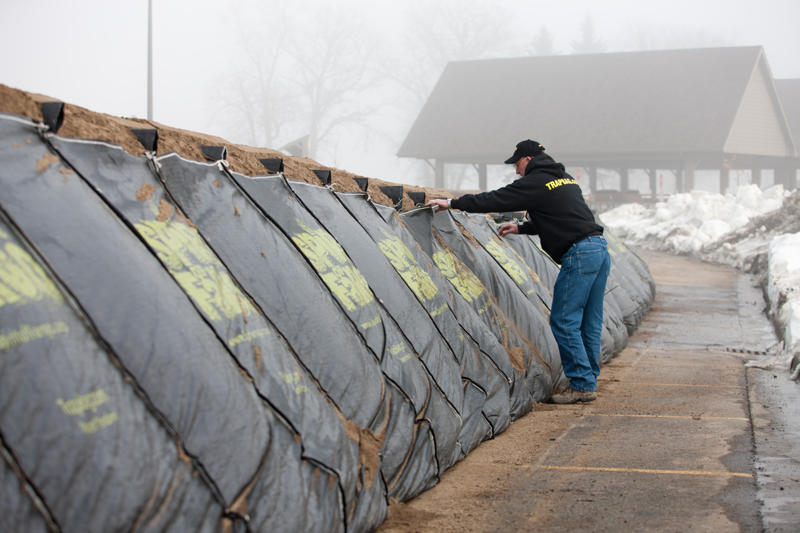What to Know When Selecting the Best Flood Prevention System
Flood prevention systems like TrapBag can make a huge difference for communities with severe flooding. They are types of flood control system that saves lives.

No singular flood prevention system works for every neighborhood, town, or city. Some may only need temporary solutions, while others might require permanent flood barriers to protect their most flood-prone areas. This guide offers a breakdown of the different types of flood barriers and how they work.
How Does A Flood Barrier Stop Water?
A good flood barrier can shield anything behind it from water, especially if it’s watertight or has multiple parts to prevent damage. Here’s a breakdown of some of the most common options and how they work.
1. Types of Flood Barriers and Flood Bags
There are a few different types of flood protection barriers and bags that can be useful during major events. Most can be divided into three general categories: temporary, semi-permanent, and permanent.
Permanent Flood Barriers
These are typically engineered projects that are designed to last. Retaining walls such as bulkheads, seawalls, and jetties can prevent floods along coastal and inland shores, preventing floods from causing serious harm to life and property.
Flood doors and floodgates are also useful as permanent structures, especially in riverside communities that are prone to repeated floods. These can remain open during periods of mild weather and be drawn shut during flooding events to mitigate severe damage.
Semi-Permanent Flood Barriers
Semi-permanent flood barriers can mitigate casualties and property loss throughout several severe flooding events. However, most are not designed to last more than 10 years at most. Options for these include door shields, water dams, reusable flood barriers such as Jersey barriers, and solutions such as TrapBag®.
Temporary Flood Barriers
Temporary flood barriers are affordable and easy to use in a pinch during emergencies. Some of the most common examples of temporary flood barriers include sandbags, water-filled diversion tubes, and modular retaining walls.
2. Benefits of Flood Barriers
Aside from the fact that flood barriers can keep water away from where it shouldn’t be, there are a few specific scenarios where they’re especially useful. Here are some examples and where they’re most likely to occur:
- River flooding: Most communities are near at least one river, meaning that while chances of a river flood are low in some areas, they’re never zero. Low-lying areas, those with certain types of soil, and those with canyon or valley-like geography are more likely to be vulnerable. This makes it essential to have flood protection barriers on hand during periods of heavy rainfall or snowmelt to prevent property damage.
- Coastal flooding: Communities along lakeshores or seashores are more likely to experience coastal flooding due to accumulated rain, severe storms, and aging infrastructure. Temporary levees can help mitigate the effects of shoreline erosion during coastal flooding events, and protect property and wildlife.
- Storm surge: Residents in hurricane-prone coastal areas know that the storm surge is often the most dangerous part of the event. They’re especially devastating in low-lying cities like New Orleans. Flood barriers can divert storm surges away from vulnerable areas, reducing the amount of damage to entire communities.
- Inland flooding: Often occurring hand-in-hand with coastal flooding, inland flooding is what occurs when heavy rains, storm surges, and other events overwhelm natural and human-constructed drainage systems. A good flood barrier can reinforce these drainage systems or divert water away from them, allowing the systems to work more efficiently.
- Flash flooding: Flash floods can occur almost anywhere when rain isn’t absorbed quickly enough, typically within a matter of hours. They can wash away roads, destroy natural areas, damage homes, and be deadly. During events like these, it’s essential not only to evacuate people to higher ground, but also to use a rapid-deploy flood barrier to mitigate the damage.
How Long Does It Take to Build a Flood Barrier?
A team of two people can assemble a TrapBag flood protection barrier within a matter of a few hours.
Some temporary flood protection barriers can activate within seconds of contact with water. However, more traditional barriers like sandbags can take hours or even days to fill and stack, while still coming with a large margin for error that can cause them to collapse.
On the other hand, permanent flood barriers can take months or years to complete, depending on the complexity of the project and other factors.
How Long Do Flood Barriers Last?
The lifespan of a flood barrier depends on the type you’re using. Here are the average lifespans of some common types of barriers and flood bags:
- Sandbags: Several months of continuous, gentle use.
- Flood bags: Up to 12 months for most products once activated
- TrapBag: Up to five years or longer, depending on the project
- Flood doors: Many years
- Levees: Up to 50–60 years, with maintenance
- Floodgates: 50–100 years, with maintenance
How to Protect Properties with TrapBag
Municipalities, neighborhood associations, and other government agencies can use TrapBag to protect entire neighborhoods, reinforce levees, divert water from overwhelmed storm drains, and much more. These barriers are also much easier to assemble than traditional barriers and cost less to deploy.
Using TrapBag to Make a Temporary Flood Barrier
Here is a breakdown of how to set up TrapBag in three easy steps:
- Take out the TrapBag: The entire TrapBag unit will be folded up in its packaging like an accordion. Remove the barrier from the package and stretch it out to your desired length, up to 50 feet.
- Fill the cells: You can do this either manually with shovels and buckets or all at once with a skid steer or bulldozer. Sand, concrete, and washed gravel make the best filler materials for TrapBag.
- Place or stack the barrier: Simply place the TrapBag barrier wherever you need it. You can use it to reinforce existing barriers or treat it as a freestanding option to protect city streets and buildings from storm surge damage.
Since TrapBag requires up to 40% less material than a sandbag barrier of the same size, this makes it an economical, life-saving option during major flooding events like a hurricane or a river cresting well past flood stage.
Prevent Flood Damage in Your Community with TrapBag
Ready to add an easy, rapid-deploy flood control system to your community’s flood protection plan? Order TrapBag now, or call us at (239) 674-6611 to protect your city today.
Meet the author
Get the Dirt Before the Flood Hits
Stay ahead of flooding, erosion, and disaster response challenges. The Dirt, TrapBag’s monthly newsletter, delivers field-tested tips, real-world case studies, and the latest in barrier technology straight to your inbox.

